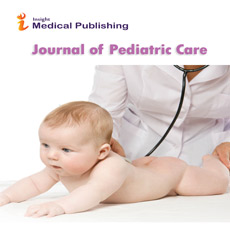Pediatric Asthma Management: Emerging Therapies and Challenges in Primary Care
Julia Fischer
Department of Pediatric and Adolescent Medicine, University of Freiburg, Freiburg, Germany
Published Date: 2025-02-28DOI10.4172/2469-5653.11.1.181
Received date: February 03, 2025, Manuscript No. ipjpc-25-20817; Editor assigned: February 05, 2025, PreQC No. ipjpc-25-20817 (PQ); Reviewed date: February 17, 2025, QC No. ipjpc-25-20817; Revised date: February 22, 2025, Manuscript No. ipjpc-25-20817 (R); Published date: February 28, 2025, DOI: 10.4172/2469-5653.11.1.281
Citation: Fischer J (2025) Pediatric Asthma Management: Emerging Therapies and Challenges in Primary Care. J Pediatr Vol.11 No.1: 281
Introduction
Asthma is one of the most common chronic respiratory conditions in children, affecting quality of life, school attendance, and long-term lung health. Despite well-established management guidelines, pediatric asthma remains a major burden on families and healthcare systems worldwide. Primary care providers are often the first point of contact, making their role in diagnosis, monitoring, and treatment crucial. Recent advances in pharmacological and non-pharmacological strategies are reshaping asthma care, but challenges such as underdiagnosis, poor adherence, and environmental triggers persist. Globally, pediatric asthma prevalence varies widely, with higher rates observed in urban and industrialized regions. Children with asthma often experience recurrent wheezing, coughing, and breathlessness, leading to frequent healthcare visits. Beyond clinical symptoms, asthma affects psychosocial well-being, limiting participation in school and physical activities. Addressing the burden requires not only effective therapies but also long-term strategies for prevention and education [1].
Description
Standard management of pediatric asthma includes inhaled corticosteroids (ICS) as the cornerstone for controlling airway inflammation. Short-acting beta-agonists (SABA) are widely used for rapid relief of symptoms, while leukotriene receptor antagonists (LTRA) provide an alternative in certain cases. Stepwise approaches, as outlined in guidelines such as those by GINA (Global Initiative for Asthma), help clinicians tailor therapy to the severity and control status of asthma. However, adherence to inhaler therapy remains a persistent challenge. Recent years have witnessed the introduction of biologics targeting specific immune pathways involved in asthma pathophysiology. By reducing exacerbations and improving lung function, biologics are expanding the therapeutic landscape. Nonetheless, their high cost and limited availability restrict widespread use, particularly in primary care settings [2].
Advances in biomarker research are enabling more personalized management of pediatric asthma. Biomarkers such as blood eosinophil counts, exhaled nitric oxide levels, and genetic profiles help identify asthma phenotypes and predict response to therapy. Precision medicine promises more effective interventions with fewer side effects, but implementing such approaches in routine primary care requires resources, training, and integration with existing healthcare systems. Proper inhaler technique is essential for effective asthma control, yet studies consistently show poor adherence among children. New inhaler designs, including breath-actuated devices and spacers, aim to improve drug delivery. Digital health innovations, such as smart inhalers with sensors and mobile applications, provide real-time monitoring and reminders, supporting both adherence and data-driven clinical decisions. Integrating these technologies into primary care offers new opportunities but also raises concerns about cost and accessibility [3].
Environmental control remains a cornerstone of pediatric asthma management. Primary care providers must educate families on minimizing exposure to allergens, pollutants, and tobacco smoke. Lifestyle interventions, such as promoting physical activity, managing obesity, and ensuring proper nutrition, also contribute to improved asthma outcomes. Recent studies suggest that dietary patterns rich in antioxidants and omega-3 fatty acids may have protective effects on airway inflammation [4].
Allergen immunotherapy, delivered either subcutaneously or sublingually, has gained recognition as a disease-modifying intervention in pediatric asthma associated with allergic sensitization. By reducing sensitivity to allergens, immunotherapy decreases symptoms and medication use while improving quality of life. Despite its promise, barriers such as long treatment duration, adherence issues, and limited expertise in primary care hinder widespread adoption. Primary care practitioners face multiple challenges in managing pediatric asthma [5].
Conclusion
Pediatric asthma management has advanced significantly with the development of biologics, precision medicine tools, and digital technologies. Yet, challenges such as underdiagnosis, poor adherence, and socio-environmental barriers remain critical in primary care. A balanced approach that combines emerging therapies with education, family engagement, and preventive strategies holds the key to improving both survival and quality of life in children with asthma. By empowering primary care providers and families alike, the global burden of pediatric asthma can be substantially reduced.
Acknowledgement
None.
Conflict of Interest
None.
References
- Javier JR, Wise PH, Mendoza FS. (2007). The relationship of immigrant status with access, utilization and health status for children with asthma. Ambul Pediatr7: 421-430.
Google Scholar Cross Ref Indexed at
- DeWalt DA, Dilling MH, Rosenthal MS, Pignone MP. (2007). Low parental literacy is associated with worse asthma care measures in children. Ambulatory Pediatrics7: 25-31.
Google Scholar Cross Ref Indexed at
- Bastain TM, Islam T, Berhane KT, McConnell RS, Rappaport EB, et al. (2011). Exhaled nitric oxide, susceptibility and new-onset asthma in the Children’s Health Study. Eur J Respir37: 523-531.
Google Scholar Cross Ref Indexed at
- Spencer-Hwang R, Pasco-Rubio M, Soret S, Ghamsary M, Sinclair R, et al. (2019). Association of major California freight railyards with asthma-related pediatric emergency department hospital visits. Prev Med Rep13: 73-79.
Google Scholar Cross Ref Indexed at
- Gauderman WJ, Avol E, Gilliland F, Vora H, Thomas D, et al. (2004). The effect of air pollution on lung development from 10 to 18 years of age. N Engl J Med351: 1057-1067.
Open Access Journals
- Aquaculture & Veterinary Science
- Chemistry & Chemical Sciences
- Clinical Sciences
- Engineering
- General Science
- Genetics & Molecular Biology
- Health Care & Nursing
- Immunology & Microbiology
- Materials Science
- Mathematics & Physics
- Medical Sciences
- Neurology & Psychiatry
- Oncology & Cancer Science
- Pharmaceutical Sciences
